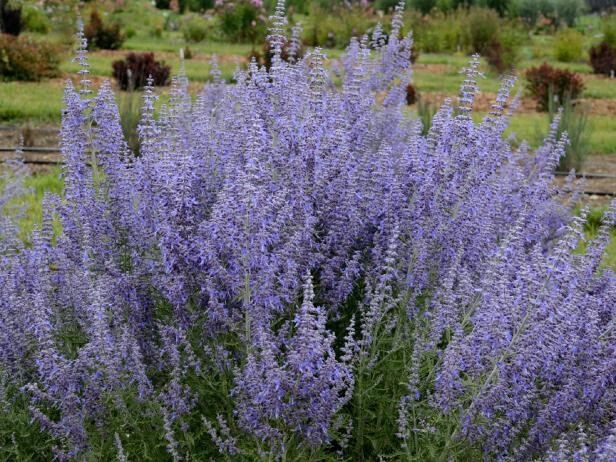Turn heads toward your perennial gardens by planting Russian sage (Perovskia atriplicifolia) in the mix. This drought-tolerant perennial dresses up the summer and fall garden with a haze of purple flowers atop grey-green leaves on silver-white stems. It’s a looker from midsummer to fall frost.

Like other members of the mint family, its leaves are aromatic when crushed, and the plants have the square stems found in many of its relatives. Despite its name, it’s not a type of sage.
Russian sage is easy to grow and cold hardy to USDA zones 5 to 9. It grows best in warm climates and tolerates clay or average soils, as long as the drainage is good, but they need full sun to produce lots of flowers and sturdy stems that won’t flop over as they grow taller.
Thanks to its low maintenance and showy, tubular flowers, Russian sage is a past recipient of the Perennial Plant Association Plant of the Year Award.
Planting Russian Sage
There are some tricks to planting Russian sage that will help the plant establish in your garden.
Start with your planting spot. Russian sage needs full sun to perform its best. Give it a little shade, and plants tend to flop open as stems stretch for sunlight. Choose a location with hot, intense sun, even as hot as the space between sidewalk and street or a strip along a driveway. Russian sage likes sun and heat.
When planting Russian sage, consider two things this beauty doesn’t like: high humidity and soil that stays soggy in winter. Choose a planting spot with well-drained average soil or alkaline, dry soil. Russian sage adapts well to either soil type. If soil is too fertile, plants tend to become loose and floppy. In this case, insert hoop stakes or use stakes and string to prop stems.
Mature plants can reach 3 to 5 feet in height with a spread of 2 to 4 feet. Since Russian sage grows as clumps, space the plants about 3 feet apart, or 3 feet away from other plants in the garden, to give them room to spread.
Look for containers of Russian sage at your favorite plant shopping spot. Although you can tackle planting Russian sage from early spring to six weeks before frost, the ideal time is in late spring. At this point, soil is warm and plants should start growing quickly. If you wind up planting Russian sage further into summer, be sure to keep soil moist as young plants establish.
Several Russian sage varieties are available on the market. The straight species grows 3 to 5 feet tall and 2 to 4 feet wide. ‘Little Spire’ Russian sage is a smaller version, reaching a tidy 18 to 24 inches tall and wide. ‘Blue Spire’ Russian sage tends to grow more upright than the species with stems that reach 2 to 3 feet tall and wide.
Russian sage spreads by self-sowing if conditions are right and also by rhizomes. In some situations, gardeners report this perennial flower as being invasive. It is not, however, reported or recorded as such in the National Invasive Species database. In the garden, keep an eye out for spreading stems. Pull and clip them as you spot them.
Russian Sage Care
Russian sage is drought-tolerant once established, but plants need water until root systems have had a chance to sink deeply into soil. It’s a good idea to water Russian sage during its first growing season to encourage a deep, extensive root system.
If the stems of your plants start to lean over—which they’re prone to do if they’re not getting adequate sunlight—stake them as needed. The next spring, prune them to six to eight inches above the ground to encourage new growth. The dried flowers are pretty in indoor arrangements.
If you prefer not to cut the plants back, let the faded flowers remain, and they’ll add interest and color to the winter landscape.
Transplanting established Russian sage can be tricky. Dig a large perimeter around the plant, taking as much soil and root system with you as you can. The plant will likely go into shock after transplanting and could take a few months to come out of it. The best time to move Russian sage is in early spring. Wait until soil is warm in the coldest regions. Cut stems back by two-thirds prior to moving the plant. Keep the transplant well-watered until you see new growth; then gradually decrease water.
How to Use Russian Sage
Because of its ability to withstand periods of drought, Russian sage is a good choice for xeriscaping. It’s also rabbit and deer resistant, and seldom has problems with pests or diseases. Hummingbirds, butterflies and bees are often drawn to them.